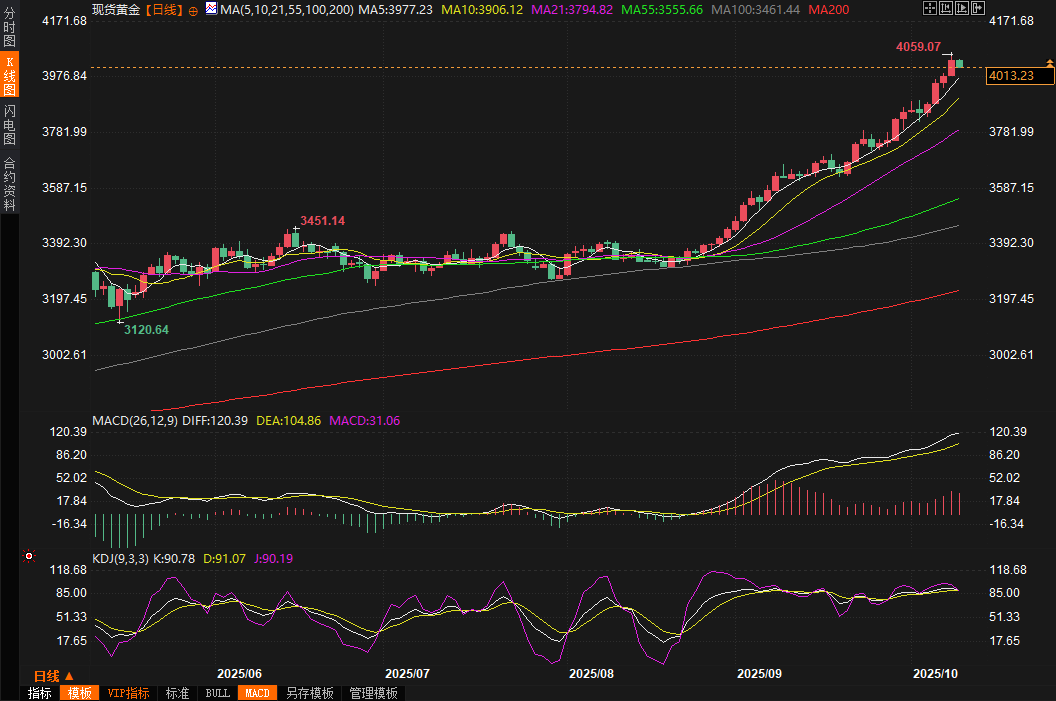Gold trading reminder: Hamas ceasefire agreement triggers gold price correction, is the "turning point" coming?
2025-10-09 07:33:51
Investors need to pay attention to further news on the situation in the Middle East and changes in risk aversion sentiment, and be wary of the possibility that this factor will prompt more bulls to take profits, thereby triggering a deep correction in gold prices. At the same time, they need to pay attention to the support of buying orders.
Multiple catalysts for gold prices to break through historical barriers
This surge in the gold market is no accident; it's the result of a combination of global macroeconomic and geopolitical uncertainties. So far this year, gold prices have risen 52%, far outperforming global stock markets and making it one of the most promising assets of 2025. Spot gold rose 1.43% on Wednesday to close at $4,041.45 per ounce, reaching an intraday all-time high of $4,059.07. U.S. December gold futures also settled up 1.7% at $4,070.5. This strong performance reflects strong investor demand for safe-haven assets, particularly amid growing expectations of a U.S. interest rate cut.
First, uncertainty surrounding US economic policy is a key driver of gold's price increases. Minutes from the Federal Reserve's September meeting showed that most policymakers supported further easing, with the market generally expecting a 25 basis point rate cut at the end of October and a 78% probability of another cut in December. This expectation has directly weakened the dollar's appeal, pushing the US dollar index, while up 0.27% to 98.83 on Wednesday, to a significant overall weakening trend. A weaker dollar typically boosts the relative value of gold, as it is denominated in US dollars. Furthermore, the lack of official economic data due to the US federal government shutdown has further exacerbated market uncertainty, making it difficult for investors to accurately assess economic conditions and leading them to seek gold as a safe haven.
Secondly, the cumulative effect of geopolitical risks cannot be ignored. Middle East tensions, global political uncertainty, and aggressive buying by central banks have all provided solid support for gold prices. Data from the World Gold Council shows that global gold ETF inflows have reached $64 billion this year, with a monthly record of $17.3 billion in September alone. This fear of missing out (FOMO) has further amplified the rally, attracting even more capital. Meanwhile, technical indicators show that gold's Relative Strength Index (RSI) has reached 88, indicating overbought conditions. However, this has not dampened bullish sentiment. Analysts predict that these factors will persist until 2026, potentially pushing gold prices towards $5,000 per ounce.
The silver market also rallied alongside gold. Spot silver rose 2.2% on October 8th, closing at $48.84 per ounce, reaching a high of $49.53 during the session, its highest level since 2011. Silver prices have risen 71% this year, driven by gold and tight spot market supply. HSBC even raised its average silver price forecasts for 2025 and 2026 to $38.56 and $44.50, respectively, citing high gold prices, recovering investor demand, and increased trading volatility. The rally also spread to other precious metals, with platinum rising 2.4% to $1,662.78 and palladium surging 7.2% to $1,434.25, demonstrating a collective boom across the precious metals sector.
The impact of linkage between the U.S. bond market and the foreign exchange market
Gold's rally isn't isolated; it's closely tied to dynamics in the US bond and foreign exchange markets. On Wednesday, the US 10-year Treasury auction saw tepid demand, with bid-to-cover ratios and indirect bid rates declining. This led to a shift in yields, with the 10-year yield rising 0.6 basis points to 4.133%. This reflects investors' cautious outlook for the US economy, particularly amid the government shutdown. The lack of data support has kept the bond market range-bound. While the Federal Reserve's meeting minutes contained no surprises, they emphasized increasing risks in the job market and supported a rate cut, further strengthening gold's appeal.
In the foreign exchange market, the yen fell to its lowest level against the dollar since mid-February, dragged down by fiscal spending concerns following the election of new Japanese Prime Minister Sanae Takaichi. Expectations of increased stimulus in Japan, including expansionary fiscal and loose monetary policies, weakened the yen's safe-haven status and bolstered the dollar. The euro also weakened due to political uncertainty in France, where the brief tenure of caretaker Prime Minister Jean-Marie Le Corny and the political crisis have heightened uncertainty. Despite Le Corny's comments that a deal on the 2026 budget is possible, the euro pared losses. The Reserve Bank of New Zealand's unexpected 50 basis point interest rate cut also underscored the global easing trend. These foreign exchange fluctuations indirectly supported gold, as the dollar's relative strength was short-lived and driven by risk aversion, but the overall weakness remained intact and drove investors toward precious metals.
Hamas ceasefire agreement: a turning point for gold price correction?
However, just as gold prices hit a new high, a sudden easing of tensions in the Middle East became a catalyst for a market turnaround. In early Asian trading on October 9th, spot gold prices fluctuated and fell 0.6%, reaching a low of around $4,011.87 by 07:22. This was directly due to the news that Hamas and Israel had reached a consensus on the first phase of the Gaza peace agreement.
Media reports show that Israel and Hamas have signed a comprehensive ceasefire agreement, which will take effect throughout the Gaza Strip at 12:00 Cairo time on October 9 (17:00 Beijing time).
US President Trump confirmed in a post on Truth Social that all hostages will be released soon, Israeli forces will withdraw to agreed-upon positions, and all parties will be treated fairly. A spokesperson for Qatar's Ministry of Foreign Affairs also stated that the mediators have reached an agreement on all terms of the ceasefire, including ending the war, releasing Israeli hostages and Palestinian prisoners, and allowing the entry of aid.
The agreement quickly cooled risk aversion in the market. Bulls began taking profits upon the ceasefire announcement, triggering a pullback in gold prices. Analysts warn that this may not be a temporary correction, but rather the beginning of a deeper correction. Because the ceasefire alleviates short-term risks, investors may turn to other assets, such as stocks or bonds. Furthermore, the longer the lack of economic data, the less predictable market volatility. If the situation in the Middle East stabilizes further, further capital outflows will intensify downward pressure on gold prices. Investors should closely monitor follow-up news, such as the implementation of the agreement and potential second phase of negotiations, as any unexpected developments could reverse the correction.
From a technical perspective, gold has been overbought for a long time, and the elevated RSI suggests room for a correction. If risk aversion continues to subside, gold could test the $4,000 mark or even lower support levels. However, global economic uncertainty persists, and expectations of interest rate cuts and central bank buying will continue to provide a buffer against a sharp decline.
Gold Market Outlook and Risks
In summary, while gold is expected to perform strongly in 2025, the pullback triggered by the Hamas ceasefire agreement reminds us that the market is not a one-way street. In the short term, gold prices are likely to fluctuate around $4,000, depending on the stability of the Middle East and the recovery of US economic data. If the ceasefire agreement is successfully implemented, the pullback could be deeper; conversely, any resurgence of conflict would reignite safe-haven demand or attract bargain-hunting, potentially pushing gold prices higher.
In the long term, multiple positive factors, such as the Federal Reserve's accommodative policy, global uncertainty, and ETF inflows, will support gold prices to higher levels, perhaps even reaching the $5,000 target. However, short-term investors should remain vigilant, guarding against profit-taking and external shocks, and avoid blindly chasing higher prices. In the short term, gold prices are likely to fluctuate widely at high levels.

(Spot gold daily chart, source: Yihuitong)
At 07:30 Beijing time, spot gold was trading at $4015.07 per ounce.
- Risk Warning and Disclaimer
- The market involves risk, and trading may not be suitable for all investors. This article is for reference only and does not constitute personal investment advice, nor does it take into account certain users’ specific investment objectives, financial situation, or other needs. Any investment decisions made based on this information are at your own risk.





















